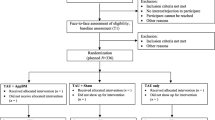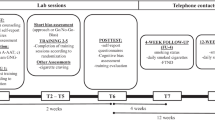Abstract
This study aimed to provide a preliminary test of the efficacy of a brief cognitive bias modification program for reducing approach bias in adult smokers motivated to quit. Participants were 52 smokers who were randomly assigned to four sessions of approach bias modification training (AAT) or sham training. Participants were asked to make a self-guided quit attempt upon completion of the final training session. Approach bias was assessed at baseline and at the end of each session, and days abstinent was assessed 1-week following the quit attempt. Individuals assigned to the AAT training condition evidenced significantly greater reductions in approach bias relative to those in the sham condition (p < .001). Baseline approach bias did not moderate the between-group effect (ps > 0.41); however, higher levels of approach bias at baseline were associated with greater approach bias reduction over time irrespective of condition (p < .001). Consistent with hypothesis, the reduction in approach bias during the intervention period was significantly related to the number of days abstinent following the quit attempt (p = .033). The present study extends recent work in alcohol use disorders by showing that approach bias reduction, in this case for smoking-related stimuli, may also facilitate smoking cessation. Clinical and research implications are discussed.



Similar content being viewed by others
References
Amir, N., Taylor, C. T., & Donohue, M. C. (2011). Predictors of response to an attention modification program in generalized social phobia. Journal of Consulting and Clinical Psychology, 79(4), 533. doi:10.1037/a0023808.
Ashare, R. L., Wileyto, E. P., Perkins, K. A., & Schnoll, R. A. (2013). The first seven days of a quit attempt predicts relapse: Validation of a measure for screening medications for nicotine dependence. Journal of Addiction Medicine, 7(4), 249. doi:10.1097/adm.0b013e31829363e1.
Becker, E. S., Ferentzi, H., Ferrari, G., Möbius, M., Brugman, S., Custers, J., Geurtzen, N., Wouters, J., & Rinck, M. (2016). Always approach the bright side of life: A general positivity training reduces stress vulnerability in vulnerable individuals. Cognitive Therapy and Research, 40, 57–71. doi:10.1007/s10608-015-9716-2.
Cousijn, J., Goudriaan, A. E., & Wiers, R. W. (2011). Reaching out towards cannabis: approach bias in heavy cannabis users predicts changes in cannabis use. Addiction (Abingdon, England), 106(9), 1667–1674. doi:10.1111/j.1360-0443.2011.03475.x.
Eberl, C., Wiers, R. W., Pawelczack, S., Rinck, M., Becker, E. S., & Lindenmeyer, J. (2013). Approach bias modification in alcohol dependence: Do clinical effects replicate and for whom does it work best?Developmental Cognitive Neuroscience ,4, 38–51. doi:10.1016/j.dcn.2012.11.002.
Faul, F., Erdfelder, E., Lang, A. G., & Buchner, A. (2007). G* Power 3: A flexible statistical power analysis program for the social, behavioral, and biomedical sciences. Behavior Research Methods, 39(2), 175–191. doi:10.3758/bf03193146.
Ferguson, S. G., Gitchell, J. G., Shiffman, S., & Sembower, M. A. (2009). Prediction of abstinence at 10 weeks based on smoking status at 2 weeks during a quit attempt: secondary analysis of two parallel, 10-week, randomized, double-blind, placebo-controlled clinical trials of 21-mg nicotine patch in adult smokers. Clinical Therapeutics, 31(9), 1957–1965. doi:10.1016/j.clinthera.2009.08.029.
Field, M., Kiernan, A., Eastwood, B., & Child, R. (2008). Rapid approach responses to alcohol cues in heavy drinkers. Journal of Behavior Therapy and Experimental Psychiatry, 39(3), 209–218. doi:10.1016/j.jbtep.2007.06.001.
Fiore, M. C., Jaen, C. R., Baker, T. B., Bailey, W. C., Benowitz, N., & Curry, S. J. (2008). Treating tobacco use and dependence: 2008 update US Public Health Service Clinical Practice Guideline executive summary. Respiratory Care, 53(9), 1217–1222.
Friese, M., Hofmann, W., & Wiers, R. W. (2011). On taming horses and strengthening riders: Recent developments in research on interventions to improve self-control in health behaviors. Self and Identity, 10(3), 336–351. doi:10.1080/15298868.2010.536417.
Heatherton, T. F., Kozlowski, L. T., Frecker, R. C., & Fagerstrom, K. O. (1991). The Fagerström test for nicotine dependence: a revision of the Fagerstrom Tolerance Questionnaire. British Journal of Addiction, 86(9), 1119–1127. doi:10.1111/j.1360-0443.1991.tb01879.x.
Heck, R. H., Thomas, S. L., & Tabata, L. N. (2013). Multilevel and longitudinal modeling with IBM SPSS. Routledge. 10.4324/9780203701249$4.
Heuer, K., Rinck, M., & Becker, E. S. (2007). Avoidance of emotional facial expressions in social anxiety: The Approach–Avoidance Task. Behaviour Research and Therapy, 45(12), 2990–3001. doi:10.1016/j.brat.2007.08.010.
Loijen, A., Rinck, M., Walvoort, S. J. W., Kessels, R. P. C., Becker, E. S., & Egger, J. I. M. (2016). Modification of automatic alcohol approach tendencies in alcohol-dependent patients with mild or major neurocognitive disorder. Manuscript submitted for publication.
Machulska, A., Zlomuzica, A., Adolph, D., Rinck, M., & Margraf, J. (2015). A cigarette a day keeps the goodies away: Smokers show automatic approach tendencies for smoking-, but not for food-related stimuli. PLoS One, 10(2), e0116464. doi:10.1371/journal.pone.0116464.
Machulska, A., Zlomuzica, A., Rinck, M., Assion, H. J., & Margraf, J. (2016). Approach bias modification in inpatient psychiatric smokers. Journal of Psychiatric Research, 76, 44–51. doi:10.1016/j.jpsychires.2015.11.015.
Man, C. N., Fathelrahman, A. I., Harn, G. L., Lajis, R., Samin, A. S. M., Omar, M., & Bayanuddin, N. A. (2009). Correlation between urinary nicotine, cotinine and self-reported smoking status among educated young adults. Environmental Toxicology and Pharmacology, 28(1), 92–96. doi:10.1016/j.etap.2009.03.003.
Perkins, K. A. (2014). Improving efficiency of initial tests for efficacy in smoking cessation drug discovery. Expert Opinion on Drug Discovery,9 (11), 1259–1264. doi:10.1517/17460441.2014.951632.
Shipton, D., Tappin, D. M., Vadiveloo, T., Crossley, J. A., Aitken, D. A., & Chalmers, J. (2009). Reliability of self reported smoking status by pregnant women for estimating smoking prevalence: a retrospective, cross sectional study. Bmj, 339, b4347. doi:10.1136/bmj.b4347.
Snijders, T. A., & Bosker, R. J. (1993). Standard errors and sample sizes for two-level research. Journal of Educational and Behavioral Statistics, 18(3), 237–259. doi:10.3102/10769986018003237.
Stacy, A. W., & Wiers, R. W. (2010). Implicit cognition and addiction: a tool for explaining paradoxical behavior. Annual Review of Clinical Psychology, 6, 551. doi:10.1146/annurev.clinpsy.121208.131444.
US Department of Health and Human Services. (2014). The health consequences of smoking—50 years of progress: A report of the Surgeon General. Atlanta, GA: US Department of Health and Human Services, Centers for Disease Control and Prevention, National Center for Chronic Disease Prevention and Health Promotion, Office on Smoking and Health,17. doi:10.1037/e510072014-001.
West, R., Zatonski, W., Przewozniak, K., & Jarvis, M. J. (2007). Can we trust national smoking prevalence figures? Discrepancies between biochemically assessed and self-reported smoking rates in three countries. Cancer Epidemiology Biomarkers & Prevention, 16(4), 820–822. doi:10.1158/1055-9965.epi-06-0679.
Wiers, C. E., Kühn, S., Javadi, A. H., Korucuoglu, O., Wiers, R. W., Walter, H., & Bermpohl, F. (2013b). Automatic approach bias towards smoking cues is present in smokers but not in ex-smokers. Psychopharmacology, 229(1), 187–197. doi:10.1007/s00213-013-3098-5.
Wiers, R. W., Eberl, C., Rinck, M., Becker, E. S., & Lindenmeyer, J. (2011). Retraining automatic action tendencies changes alcoholic patients’ approach bias for alcohol and improves treatment outcome. Psychological Science, 22(4), 490–497. doi:10.1177/0956797611400615.
Wiers, R. W., Gladwin, T. E., Hofmann, W., Salemink, E., & Ridderinkhof, K. R. (2013a). Cognitive bias modification and cognitive control training in addiction and related psychopathology mechanisms, clinical perspectives, and ways forward. Clinical Psychological Science. doi:10.1177/2167702612466547.
Wiers, R. W., Rinck, M., Kordts, R., Houben, K., & Strack, F. (2010). Retraining automatic action - tendencies to approach alcohol in hazardous drinkers. Addiction, 105(2), 279–287. doi:10.1111/j.1360-0443.2009.02775.x.
Wileyto, E. P., Patterson, F., Niaura, R., Epstein, L. H., Brown, R. A., Audrain-McGovern, J., & Lerman, C. (2004). Do small lapses predict relapse to smoking behavior under bupropion treatment?Nicotine & Tobacco Research, 6(2), 357–367. doi:10.1080/1462220042000202463.
Zhou, X., Nonnemaker, J., Sherrill, B., Gilsenan, A. W., Coste, F., & West, R. (2009). Attempts to quit smoking and relapse: factors associated with success or failure from the ATTEMPT cohort study. Addictive Behaviors, 34(4), 365–373. doi:10.1016/j.addbeh.2008.11.013.
Acknowledgements
This study was in part funded by a Grant from the National Institute on Drug Abuse: R34 DA034658-01 (awarded to Dr. Smits)
Author Contribution
SOB, MR, and JAJS designed the randomized controlled trial. SOB, MLD, DR, and JAJS wrote the first draft. DR and MLD conducted the statistical analyses. SOB and JRF collected the data. All authors worked to revise the manuscript and approved the final version.
Author information
Authors and Affiliations
Corresponding author
Ethics declarations
Conflict of Interest
Scarlett O. Baird, Mike Rinck, David Rosenfield, Michelle L. Davis, Jillian R. Fisher, Eni S. Becker, Mark B. Powers, and Jasper A. J. Smits have no conflicts of interest with respect to the research, authorship, and publication of the manuscript.
Informed Consent
Informed consent was obtained from all individual participants included in the study.
Animal Rights
This article does not contain any studies with animals performed by any of the authors.
Additional information
Trial Registration ClinicalTrials.gov, NCT02481752, https://clinicaltrials.gov/ct2/show/NCT02481752
Rights and permissions
About this article
Cite this article
Baird, S.O., Rinck, M., Rosenfield, D. et al. Reducing Approach Bias to Achieve Smoking Cessation: A Pilot Randomized Placebo-Controlled Trial. Cogn Ther Res 41, 662–670 (2017). https://doi.org/10.1007/s10608-017-9835-z
Published:
Issue Date:
DOI: https://doi.org/10.1007/s10608-017-9835-z




